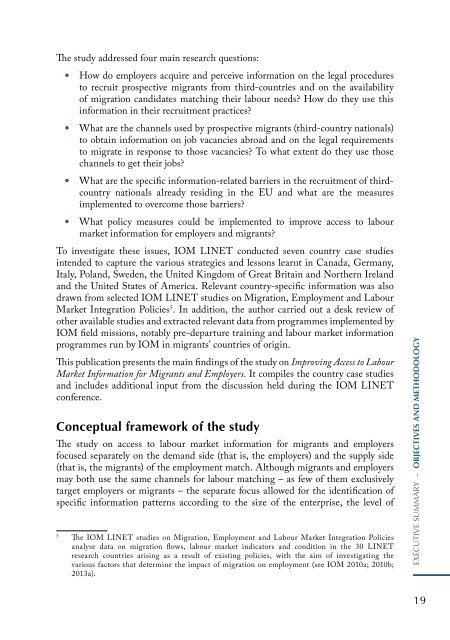International Organization for Migration (IOM)
International Organization for Migration (IOM)
International Organization for Migration (IOM)
You also want an ePaper? Increase the reach of your titles
YUMPU automatically turns print PDFs into web optimized ePapers that Google loves.
The study addressed four main research questions:<br />
• How do employers acquire and perceive in<strong>for</strong>mation on the legal procedures<br />
to recruit prospective migrants from third-countries and on the availability<br />
of migration candidates matching their labour needs? How do they use this<br />
in<strong>for</strong>mation in their recruitment practices?<br />
• What are the channels used by prospective migrants (third-country nationals)<br />
to obtain in<strong>for</strong>mation on job vacancies abroad and on the legal requirements<br />
to migrate in response to those vacancies? To what extent do they use those<br />
channels to get their jobs?<br />
• What are the specific in<strong>for</strong>mation-related barriers in the recruitment of thirdcountry<br />
nationals already residing in the EU and what are the measures<br />
implemented to overcome those barriers?<br />
• What policy measures could be implemented to improve access to labour<br />
market in<strong>for</strong>mation <strong>for</strong> employers and migrants?<br />
To investigate these issues, <strong>IOM</strong> LINET conducted seven country case studies<br />
intended to capture the various strategies and lessons learnt in Canada, Germany,<br />
Italy, Poland, Sweden, the United Kingdom of Great Britain and Northern Ireland<br />
and the United States of America. Relevant country-specific in<strong>for</strong>mation was also<br />
drawn from selected <strong>IOM</strong> LINET studies on <strong>Migration</strong>, Employment and Labour<br />
Market Integration Policies5 . In addition, the author carried out a desk review of<br />
other available studies and extracted relevant data from programmes implemented by<br />
<strong>IOM</strong> field missions, notably pre-departure training and labour market in<strong>for</strong>mation<br />
programmes run by <strong>IOM</strong> in migrants’ countries of origin.<br />
This publication presents the main findings of the study on Improving Access to Labour<br />
Market In<strong>for</strong>mation <strong>for</strong> Migrants and Employers. It compiles the country case studies<br />
and includes additional input from the discussion held during the <strong>IOM</strong> LINET<br />
conference.<br />
Conceptual framework of the study<br />
The study on access to labour market in<strong>for</strong>mation <strong>for</strong> migrants and employers<br />
focused separately on the demand side (that is, the employers) and the supply side<br />
(that is, the migrants) of the employment match. Although migrants and employers<br />
may both use the same channels <strong>for</strong> labour matching – as few of them exclusively<br />
target employers or migrants – the separate focus allowed <strong>for</strong> the identification of<br />
specific in<strong>for</strong>mation patterns according to the size of the enterprise, the level of<br />
5 The <strong>IOM</strong> LINET studies on <strong>Migration</strong>, Employment and Labour Market Integration Policies<br />
analyse data on migration flows, labour market indicators and condition in the 30 LINET<br />
research countries arising as a result of existing policies, with the aim of investigating the<br />
various factors that determine the impact of migration on employment (see <strong>IOM</strong> 2010a; 2010b;<br />
2013a).<br />
eXecutIve summAry – OBJECTIVES AND METHODOLOGY<br />
19


